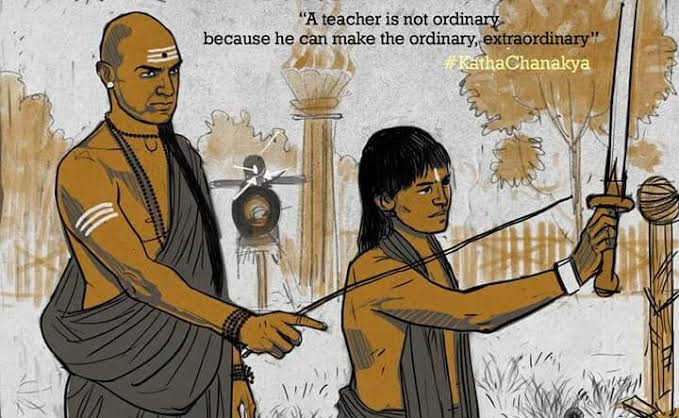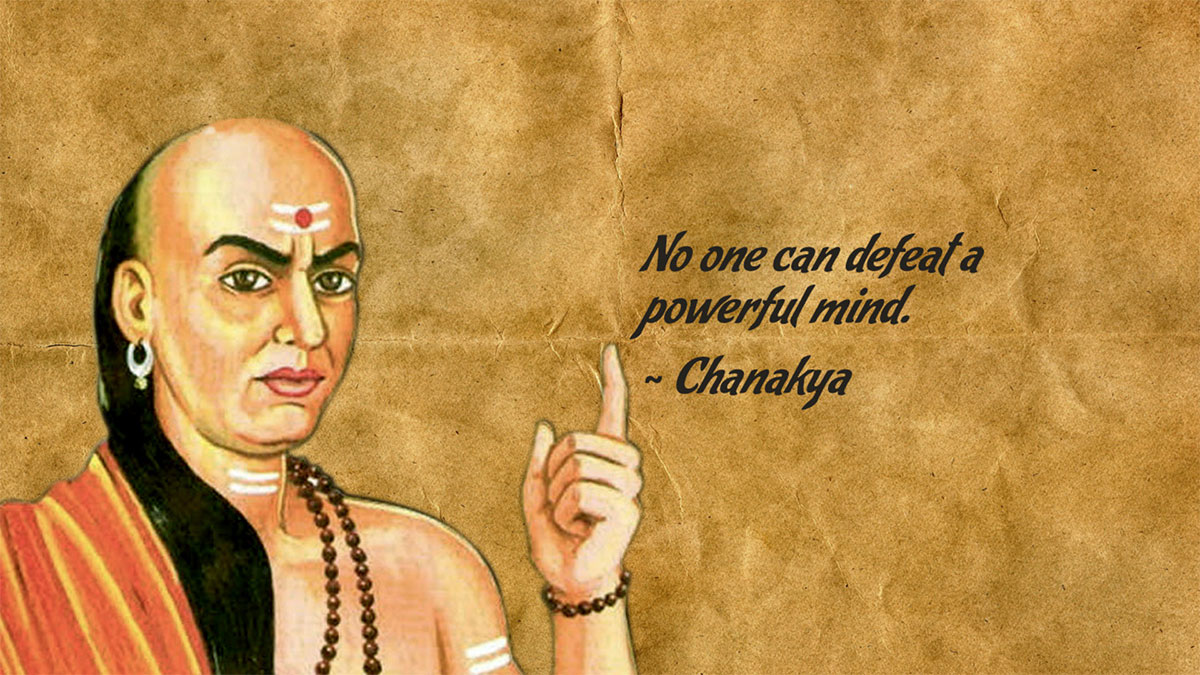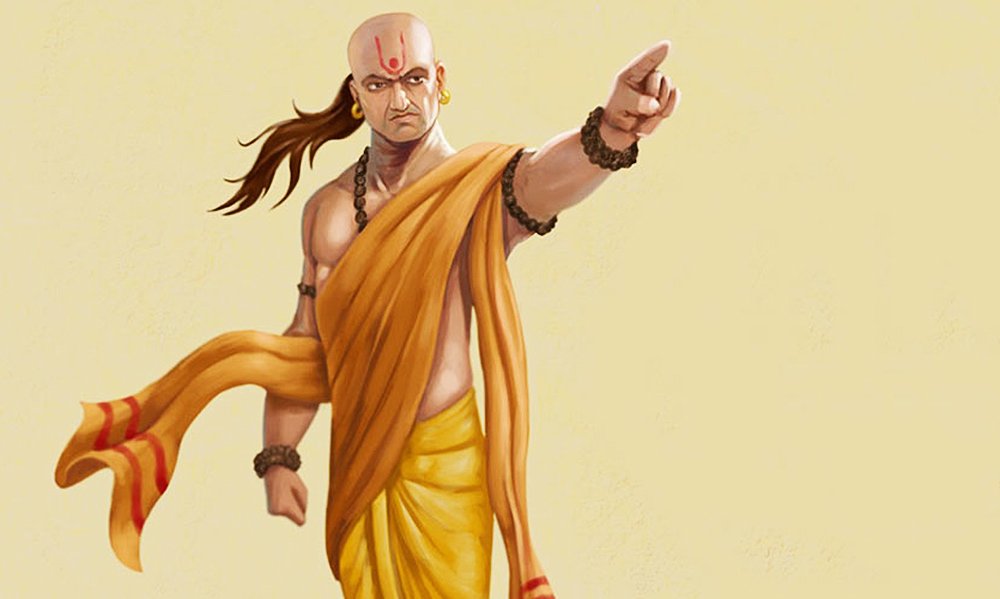In the sprawling ancient city of Takshashila, where knowledge flowed like the gentlest of streams, the words of Chanakya’s profound wisdom echoed through the corridors of time. Within these venerable walls, scholars, philosophers, and seekers of wisdom gathered to quench their thirst for learning. It was amidst this vibrant blend of intellect that the fateful encounter between Chanakya and Chandragupta Maurya transpired, setting the stage for one of history’s most remarkable tales of mentorship.
Chanakya was a well-known teacher who taught at Takshashila University, an old Indian university that is currently located in Pakistan’s Rawalpindi region. Chanakya, also known as Vishnugupta or Kautilya, wrote the ancient Indian political theory Arthashastra. He is widely regarded as a forefather of Indian political science and economics.
Chandragupta Maurya, the founder of the Mauryan Empire, graced history with a life that reads like a captivating fairy tale. His journey unfolded against the backdrop of an era that featured an evil king, a brilliant mentor, and a profound love story. As the pioneer unifier of India, Chandragupta’s legacy remains etched as a cornerstone of the subcontinent’s history. His reign, marked by astute governance and strategic brilliance, held an unparalleled place in the annals of Indian leadership.
Chanakya’s timeless words, “Education is the best friend. An educated person is respected everywhere. Education beats the beauty and the youth,” serve as the guiding light that elucidated his path towards recognizing the latent potential within Chandragupta. These words were not merely platitudes, however, a creed that Chanakya lived by, a compass that directed his discerning gaze toward uncovering raw talent.
One day, as the market bustled with its usual activity, Chanakya’s observant eyes fell upon a group of boys engaged in a game of play pretend. Chandragupta, standing at the center of this imaginative kingdom, portrayed a king, while his companions assumed the roles of guards. The play took an unexpected turn when a mock prisoner, accused of stealing food, was brought before Chandragupta’s improvised court.
Intriguingly, Chandragupta displayed an understanding that belied his age. He not only meted out punishment but also imposed a greater penalty upon himself – a vivid demonstration of empathy and accountability. He elucidated that a hungry citizen implied the king’s failure to provide for his people. This display of ethical insight caught Chanakya’s attention, a manifestation of principles that resonated with the sage’s own beliefs.
Impressed by Chandragupta’s exceptional sensibilities, Chanakya sought the approval of the young boy’s mother to take him under his wing as a disciple. Her assent marked the initiation of an extraordinary mentorship that would transcend the ordinary norms of teacher-student relationships.
Chanakya, a luminary in his own right, recognized in Chandragupta the uncut gem of potential. A strategist, philosopher, and teacher of remarkable acumen, Chanakya’s influence was akin to the forging of a blade, honing Chandragupta’s raw talents with meticulous care. Under his tutelage, Chandragupta’s evolution into an exemplary ruler was underway. The mentor worked tirelessly, imparting linguistic proficiency, cultivating diplomatic finesse, and ingraining strategic thinking.
In this dynamic relationship, Takshashila was more than a backdrop; it was a crucible of transformation. The echo of Chanakya’s words became the ground for Chandragupta’s growth, and his mentor’s unwavering guidance became the compass that led him toward his destiny. The once-imaginative game in the market unveiled the portrait of a potential king, a portrait Chanakya saw with unmatched clarity.
As history would affirm, Takshashila bore witness to the alchemy of mentorship – a sage’s discernment fusing with a young man’s potential, birthing a ruler who would stand as a pillar of leadership for generations to come. Through the web of words and actions, a legacy emerged that resonates with the profound impact of education and mentorship.
Let’s embark on a journey that stands as an exemplar of mentorship that transcends time and cultural boundaries – the saga of Chanakya’s mentoring Chandragupta Maurya.
Chanakya’s Methodical Mentorship: Nurturing Chandragupta into a King

Chanakya’s mentorship of Chandragupta Maurya was a detailed and comprehensive process that transformed a young man into a visionary ruler. Chanakya’s mentorship encompassed a range of skills, values, and knowledge, providing Chandragupta with the tools needed to excel as a leader.
1. Recognition of potential
The incident of Chandragupta roleplaying with his friends showcased his empathetic approach, critical thinking, and moral compass – attributes that resonated deeply with Chanakya’s values. Through this simple play, the sage saw beyond the surface, recognizing the potential for greatness within the young man. This recognition was the pivotal first step in Chanakya’s methodical mentorship process, setting the foundation for the transformative journey that was to follow.
In acknowledging Chandragupta’s qualities during their encounter in Takshashila’s lively ambiance, Chanakya laid the cornerstone for an unparalleled mentorship that would shape not only the course of Chandragupta’s life but also the destiny of an empire.
2. Ethical foundation
Having recognized Chandragupta’s potential, Chanakya embarked on the critical task of laying an ethical foundation that would serve as the bedrock of his leadership. The sage recognized that a leader’s moral compass was as vital as his strategic acumen. Through thought-provoking lessons and practical examples, Chanakya instilled in Chandragupta the importance of upholding dharma (righteousness) in all aspects of ruling.
Chanakya presented Chandragupta with a hypothetical scenario involving a choice between personal gain and the welfare of the people. He depicted a situation where a valuable piece of land was discovered, and the ruler had the option to seize it for personal wealth.
Through this scenario, Chanakya ignited a dialogue that delved into the ethical dilemma of balancing personal interests with the greater good. Chandragupta, under his mentor’s guidance, navigated the intricacies of this moral conundrum. Chanakya not only encouraged him to weigh the short-term gains but also to consider the long-term implications on the citizens’ trust and the empire’s stability.
This learning ingrained in Chandragupta the value of prioritizing the welfare of the state over personal desires, a lesson that resonated deeply with the principles of dharma. Chanakya’s teaching went beyond theoretical discussions – it was about cultivating a moral compass that would guide Chandragupta’s decisions as a ruler.
3. Diverse knowledge
Chanakya’s commitment to Chandragupta’s holistic development extended beyond mere theoretical concepts. Recognizing that a well-rounded ruler needed a comprehensive understanding of various disciplines, Chanakya embarked on the mission of building Chandragupta’s knowledge across diverse fields.
Chanakya believed that a wise leader must draw lessons from the past to navigate the present and shape the future. To illustrate this, he presented Chandragupta with a historical account of a previous empire’s rise and fall due to strategic blunders.
As they delved into the intricacies of this historical narrative, Chanakya encouraged Chandragupta to analyze the causes behind the empire’s decline. They discussed how a lack of economic stability, internal dissent, and inadequate legion preparedness had contributed to its downfall. Through this analysis, Chanakya instilled in Chandragupta the significance of learning from history to avoid repeating the mistakes of the past.
Beyond history, Chanakya exposed Chandragupta to philosophy, emphasizing the importance of understanding different schools of thought. He introduced him to statecraft and diplomacy, teaching him the art of negotiation and international relations. They discussed economic principles, delving into the intricacies of trade, taxation, and resource management. Military strategy was another vital aspect, where Chanakya elaborated on tactics, formations, and the importance of a well-trained army.
By immersing Chandragupta in these diverse fields, Chanakya provided him with the intellectual tools to comprehend the complexities of ruling. This multidisciplinary education equipped Chandragupta with the ability to make informed decisions that considered the broader implications for the empire and its people. The example of their exploration of history highlights Chanakya’s method of not only imparting knowledge but also fostering critical thinking and analytical skills that were essential for effective leadership.
4. Resilience and adaptability
Adversity is the crucible in which leaders are forged. Just as gold is refined through fire, a leader’s resilience and adaptability are honed through challenges.
In Chanakya’s mentorship journey, resilience and adaptability were deemed crucial traits for a leader to possess. Recognizing that challenges and adversity were inevitable in the journey of leadership, he orchestrated scenarios that would test Chandragupta’s mettle and forge his resilience.
One stirring example of this approach was the “Trial of the Unplanned Crisis.” Chanakya thoroughly designed a situation where the empire faced an unforeseen crisis – an outbreak of a deadly disease that threatened the population. Chandragupta was confronted with a scenario where the resources were stretched thin, the people were in panic, and the stability of the empire was at stake.
As Chandragupta grappled with the gravity of the situation, Chanakya observed his response closely. Instead of providing immediate solutions, Chanakya encouraged Chandragupta to assess the situation, consult advisors, and devise a plan under the pressure of uncertainty. This trial aimed not only to assess Chandragupta’s crisis management skills but also to cultivate his adaptability and resilience in the face of unexpected challenges.
Throughout this trial, Chanakya guided Chandragupta, offering insights and encouraging him to view the crisis from various angles. The process of grappling with the crisis, making tough decisions, and seeking innovative solutions honed Chandragupta’s ability to remain composed under pressure and adapt to rapidly changing circumstances.
This deliberate approach of challenging Chandragupta with difficult situations wasn’t just about testing his abilities; it was about fostering a mindset that could thrive amidst adversity. Chanakya’s method aimed to ensure that Chandragupta not only possessed the knowledge and skills required for leadership but also had the inner strength to weather storms, adapt strategies, and emerge stronger from challenges – a true testament to Chanakya’s commitment to molding a resilient and adaptable leader.
5. Independent decision-making
Chanakya recognized the pivotal phase of fostering independence and self-reliance in his protege. As Chandragupta’s confidence grew and his grasp of governance deepened, Chanakya strategically transitioned from a guiding hand to a facilitator of independent decision-making, nurturing the emergence of a self-assured and visionary leader.
A guiding principle that Chanakya shared with Chandragupta during this phase encapsulates this shift perfectly: “A leader who solely relies on others’ counsel risks becoming a puppet, while a leader who listens, evaluates, and decides for themselves becomes the master of their destiny.”
To exemplify this principle, Chanakya introduced Chandragupta to a scenario that demanded decisive action. A neighboring state sent a proposal for a strategic alliance that could potentially bolster its military strength. Chandragupta’s advisors presented their views on the matter, each advocating a different approach.
Instead of imposing his own solution, Chanakya encouraged Chandragupta to analyze the proposal, considering both the short-term benefits and the long-term consequences. Under his mentor’s guidance, Chandragupta sought advice, questioned assumptions, and examined the proposal from all angles.
Ultimately, Chandragupta made a decision that aligned with his understanding of the empire’s goals, its current state, and its future aspirations. Chanakya stood by his side, watching as Chandragupta took the first steps toward leading with autonomy. The decision was not merely about the alliance but about Chandragupta’s growth as an independent decision-maker.
Through this scenario, Chanakya instilled in Chandragupta the confidence to trust his judgment, to embrace accountability, and to take ownership of the consequences of his decisions. This marked a pivotal juncture in their mentorship, as Chanakya’s deliberate encouragement of independent decision-making propelled Chandragupta toward becoming a leader who was not swayed by external pressures but guided by his own convictions and wisdom.
6. Guided Ascension to Empire
Guided by Chanakya’s wisdom, Chandragupta Maurya’s journey culminated in the ultimate test of leadership – ascending the throne and steering the ship of the Maurya Empire. As Chandragupta stepped into his role as a ruler, he put into practice the culmination of all he had learned under Chanakya’s mentorship, solidifying his place as a visionary monarch.
“The mark of a true leader lies not only in the pursuit of power but in the pursuit of the greater good for all.”
Chandragupta implemented policies that addressed the welfare of his subjects. Inspired by Chanakya’s emphasis on equitable governance, Chandragupta initiated schemes that improved agriculture, trade, and infrastructure. His taxation reforms alleviated the burdens on the common people, fostering economic growth and prosperity.
Chanakya’s guidance resonated in Chandragupta’s diplomatic finesse as well. Skillfully navigating complex alliances, he expanded the empire’s borders through strategic military campaigns, yet his approach was tempered by a commitment to avoid unnecessary conflict.
In realizing his vision for a just and prosperous realm, Chandragupta not only fulfilled his own potential but also validated Chanakya’s meticulous mentorship. The Maurya Empire stood as a testament to their collaboration, demonstrating that effective mentorship transcends instruction to cultivate leaders who leave a lasting legacy of progress and impact.
Food For Thought For Leaders

The mentorship of Chanakya and Chandragupta imparts invaluable insights for contemporary leaders. From recognizing the hidden potential to fostering ethical foundations, adapting to challenges, and empowering independent decision-making, their journey offers a timeless blueprint for effective and visionary leadership.
Recognition of Potential
Just as Chanakya perceived greatness within Chandragupta’s modest demeanor, leaders must acknowledge that untapped potential resides in unexpected quarters. Fostering talent, irrespective of origin, has the potential to yield extraordinary achievements, underlining the significance of inclusivity and recognizing the hidden strengths within their teams.
Ethical Foundation
In the realm of modern leadership, constructing a robust ethical foundation is paramount. Leaders should place a premium on values such as empathy, accountability, and integrity, recognizing that these principles steer decision-making and cultivate an environment of trust and authenticity.
Possibility Thinking rather than Probability Thinking
When Chanakya observed Chandragupta roleplaying as a king, he transcended the realm of probability. Instead of passively leaving the course of history to chance, Chanakya recognized the potential within Chandragupta, envisioning him not as a mere student but as an undeniable force that could shape an empire. This foresight exemplifies the essence of Possibility Thinking – this mindset helps to look beyond what is obvious and visible. Rather than confining themselves within the bounds of probability, visionary leaders understand that greatness is often born when one dares to explore the uncharted territories of possibility.
Balancing Power with Responsibility
The mentorship here underscores power’s delicate equilibrium with responsibility. Leaders must internalize that their role transcends authority, encompassing a duty to serve the collective welfare. In balancing influence with accountability, modern-day leaders uphold the values of ethical leadership and contribute to societal progress. This dynamic echoes the age-old wisdom that leadership, at its core, is an avenue to advance overall well-being.
Continuous Learning
The mentorship’s lifelong learning journey emphasizes the ceaseless quest for knowledge. Today’s leaders must acknowledge that growth is perpetual, seeking insights from mentors and peers to refine their leadership skills. Just as Chandragupta’s tutelage evolved over time, leaders embracing continuous learning enrich their perspectives, adapt to changing landscapes, and ensure their leadership remains relevant and effective in an ever-evolving world.
The timeless bond between Chanakya and Chandragupta reverberates through history, reminding us of the enduring impact of mentorship. As modern leaders, we stand to gain immeasurably from the wisdom of this relationship. From recognizing the hidden potential to fostering ethical foundations, adapting to challenges, and empowering independent decision-making, the footsteps of these two figures illuminate the path to effective and visionary leadership.
In the words of Chanakya –
“उत्तिष्ठते जाग्रते प्राप्य वरान्निबोधत।”
“Arise, awake, and stop not until the goal is reached.”
This exhortation echoes through time, urging leaders to awaken to their potential and pursue their noble aspirations with unwavering determination. In mentorship, as in leadership, lies the promise of progress, for when knowledge is shared and guidance is given, greatness emerges not only in the individual mentee but in the legacy they create for generations to come.
https://www.linkedin.com/pulse/corporate-chanakya-my-journey-world-arthashastra-business-shinde
https://festivals.iloveindia.com/teachers-day/relationship/chanakya-chandragupta.html
https://chanakya.one/chandragupta-maurya/
https://varnan.in/chandragupt-maurya/
https://www.linkedin.com/pulse/leadership-lessons-from-story-emperor-chandragupta-maurya-rahul-pawar
https://nykdaily.com/2020/04/6-incredible-leadership-lessons-chandraguptas-life-can-teach-you/
https://pbs.twimg.com/media/E-fsB6hVkAAS2wL.jpg
https://focusu.com/wp-content/uploads/2020/09/894EC5FF-F908-4C1F-83DF-247676C129AE.png
Written By: Jimmy Jain
Edited By: Afreen Fatima
Society of Design Thinking Professionals









